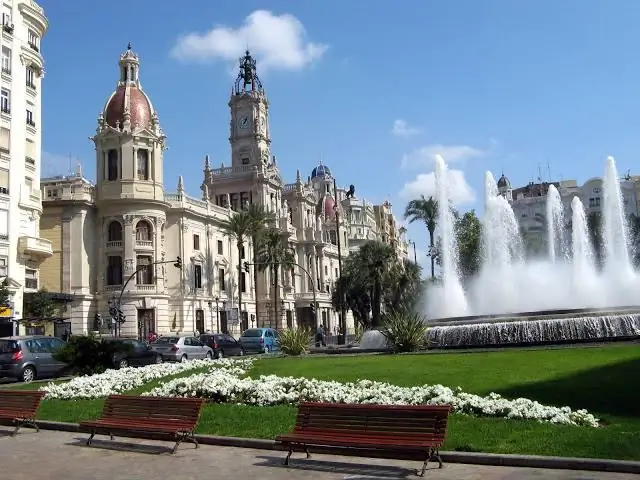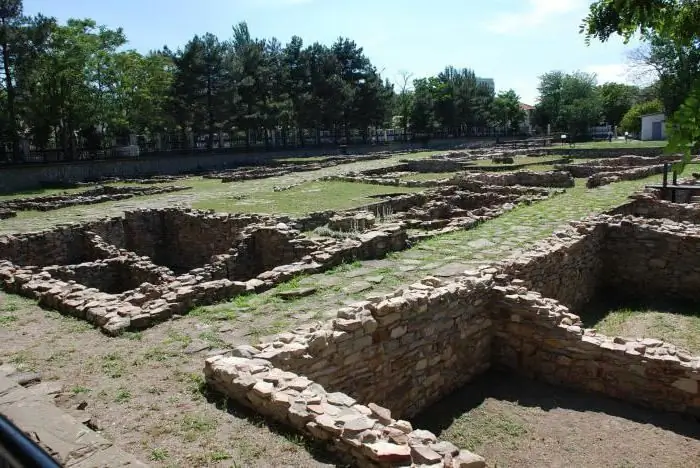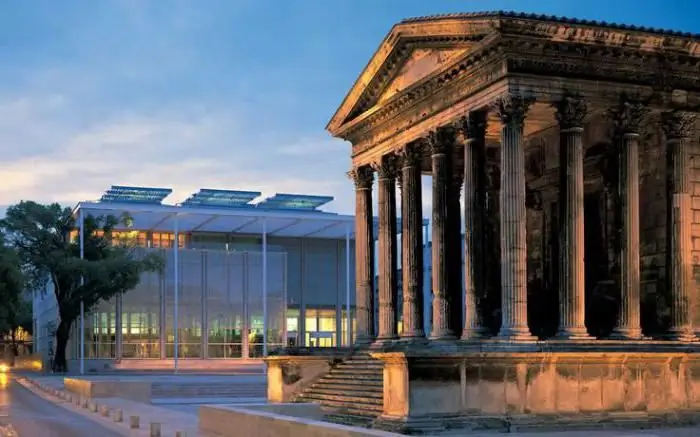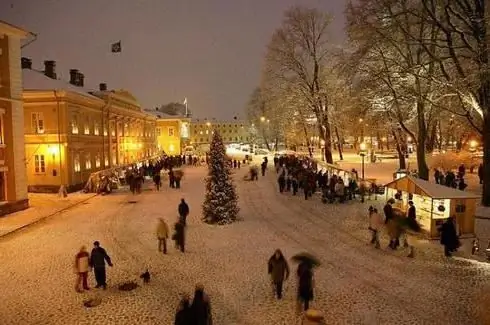- Author Harold Hamphrey [email protected].
- Public 2023-12-17 10:06.
- Last modified 2025-01-24 11:10.
Even in early childhood, each of us listened to fairy tales about magical abandoned cities in the distant jungle. Such a lost place for centuries is the dream of any traveler. It turns out that in India there is an abandoned city of Fatehpur Sikiri, and it is not at all fabulous. Once it was full of life, but now you can only admire the former greatness.
Location of the city
Currently, Fatehpur Sikri is an open-air museum city. It is located forty kilometers from the ancient village of Agra, in the Indian state of Uttar Pradesh. The road leading to the ancient city rests against the lancet gates of the fortress. The entire complex is surrounded by fortified walls, demonstrating its former power.
First impression
Of course, even on the outskirts of the city, its charm is striking. There is some mystery in this place, bordering on a fairy tale. But the whole amazing mood is spoiled by crowds of tourists and numerous guides inviting guests. No wonder it is believed that Fatehpur Sikri is a mystery that is timeless. Once you enter the complex, you realize how stunningly beautiful it is.and unusual. Apparently, its creator made the dream of real paradise come true.

Entering the territory of Fatehpur Sikri, tourists find themselves in a huge courtyard with a beautiful lawn. But in the era of prosperity of the city, the courtyard was completely covered with expensive carpets. But even now the place makes a strong impression.
The history of the creation of the city
This is now Fatehpur Sikri, a ghost town that embodies oriental tales. Its creator, the Mongol ruler Akbar the Great, probably dreamed of the prosperity of the paradise he created. But, unfortunately, fate decreed otherwise.
Akbar's grandfather was a famous commander named Zahiruddin Babur, who in 1525 defeated the troops of the Delhi emperor Ibrahim Lodi. He founded the Mughal Empire, which became the most powerful power in Hindustan. The country can be safely called a symbol not only of eastern we alth, but at the same time of despotism.

In 1568 the grandson of the conqueror - Akbar - was just at the peak of his strength and glory. His powerful empire grew stronger year after year, and the treasury was full of gold. The emperor was married, and according to tradition, he had far from one wife, each of whom was beautiful and smart. And yet Akbar was not happy and satisfied with life to the fullest. And he had a reason for that. None of the wives gave him a son, which means that the empire had no heir. Akbar heard about Saint Salim Chishti, who lived in a distant, very small village called Sikiri. With hopethe emperor went to his heart like a simple pilgrim.
Maybe Saint Chishti's prayers were answered. He predicted to the emperor that the birth of three sons awaits him ahead. One of the legends says that Chishti even sacrificed one of his children. Whether this is true or not is not exactly known. Most likely, this is just a beautiful legend. Nevertheless, the prophecy of the saint soon came true. In August 1569, Akbar finally received the long-awaited heir. The prince was named Salim after the Sufi. This is how the future head of the country, Jahangir, was born. Akbar's happiness knew no bounds. He made a decision that it was worth living next to a sage. Therefore, he began the construction of a new capital near the village of Sikri.
Construction of Fatehpur Sikri
The Emperor thoroughly approached the matter. He invited the best masons and architects, who created stunning palaces, pavilions, verandas, framed with carvings and ornaments. Fatehpur Sikri became the first Mughal city built according to plan. Everything was thought out to the smallest detail. Akbar managed to create the Mughal style that we have seen so many times in films, which is a mixture of Rajput and Muslim architecture. The city was built of marble and red sandstone. Thus, in a decade and a half, the deserted hill turned into a chic fortress. In the hotel courtyard, a dwelling was built for the sage, who predicted the birth of a son to the emperor.

After a very successful campaign against Gujarat, the emperor named his city Fatehpur Sikri, which meansmeans "city of Victory near Sikri". It is located on a hill surrounded by stone fortress walls with nine gates. The complex itself, in fact, consists of two parts - temple and residential.
Beautiful Garden City
The residential part of Fatehpur Sikri is called Dualat Khana, which translates as "the abode of fate." On its territory there are pavilions for private and public audiences, a playground, a five-story palace, a treasury and palaces for each queen. The sight of tourists is invariably attracted by the Panch Mahal - a five-tiered palace, which is also called the "wind catcher". All floors of the building are decorated with openwork columns, and each subsequent floor has a smaller area than the previous one. The palace was specially made in such a light and airy style so that the wind penetrated into all its parts, because there were no air conditioners before. Therefore, we had to make the most of natural opportunities.

The columns of the palace are very unusual. They are decorated with carvings and have different shapes: there are round, patterned, with lilies, etc. And the dome with an openwork screen completes the look of the building. There is a gazebo near the building. It is said to have been one of the first schools in India for women. Court girls were taught the basics of counting and writing here.
Royal Apartments for the Wives
On the opposite side of the gazebo is the abode of the Turkish wife of the emperor. The palace is decorated with patterned stone screens, arabesques, and the roof is covered with an unusual material resembling tiles. They say that the sultana asked to build for herstone bas-relief depicting animals. It is still inside the palace to this day. But all the heads of animals are beaten off on it, since Islam does not allow depicting living beings in this way. Who spoiled the panel is not known for certain. Perhaps this was done already at the time when tourists visited the dead city.
Akbar was generous to his wives. Each of them had its own palace, decorated with carvings and interesting ornaments. The buildings were equipped with airy balconies, domes and colonnades. The queens could walk around the beautiful courtyards and terraces.
It is known that the palace of the Queen Mother was decorated with golden frescoes depicting scenes from the Persian epic.

From the windows of the palace of the Turkish wife overlooking the reservoir Anup-Talo, in the center of which is an island. It has four bridges. One of the court chroniclers recorded in writing that in 1578 the emperor ordered the reservoir to be filled with copper, silver and gold coins as a sign of “generosity to his subjects.”
Dream Room
The city of Fatehpur Sikri is full of interesting buildings. One of them is the emperor's bedchamber or dream room, as it was also called. The padishah's bedroom is a huge room with a pedestal in the middle, on which the bed rises. And there is only water around. In fact, only the bed rises above the water. The bedroom was built in this way for a reason. With the help of water, several problems were solved at once. First, the emperor received such a valuablecoolness, and secondly, the water helped to hear the enemy who entered the bedchamber. The bedroom still has yellow and blue frescoes. There are the same ones in the secret room located opposite the padishah's library, which numbered about 25 thousand manuscripts.
In the residential part of the Fatehpur Sikri fortress (India), Akbar received guests, had fun and rested. Between the buildings of the palaces is pachisi court - an ancient Indian game. The play yard resembles a chessboard. It is fully tiled.
The Treasury of the Padishah
Fatehpur Sikri (India) had its own treasury. It is believed that it was located in Ankh-Michauli, which is confirmed by the very massive walls of the pavilion. However, there is another version according to which women played hide and seek in this building, which explains the great number of labyrinths in it.

Which hypothesis is correct, no one knows for sure. However, the appearance of the columns of the building, which are decorated with mythical creatures in the form of monsters, speaks in favor of the first version. It is likely that such guardians could well have been created on the treasury.
State meeting place
The ancient city of Fatehpur Sikri was equipped with all the buildings that could be needed for a comfortable life. The emperor daily engaged in important state affairs. In addition to his personal office, there was also a sofa-i-aam - this is the place where Akbar received people. Sessions of justice and important state meetings were held here. In the hall there is a real imperial throne, covered with openwork screens,towering on a carved pedestal.
And in front of this pavilion in the courtyard is a large stone ring dug into the ground. They say that a real state elephant was tied to it, which resolved a controversial case. There is a legend that in the event that the padishah found it difficult to make the right decision, he ordered the two disputing parties to appear before the elephant. The one whom the animal trampled first was considered the loser. Although, he didn't care anymore. By the way, the elephant is buried on the territory of Fatehpur Sikri, near the Hiran Minar tower.
Emperor's entourage
For personal meetings, the padishah had separate chambers - Divan-i-Khas. The pavilion incorporated a mixture of styles. It is decorated with exquisite carvings with elements and symbols belonging to different religions. The hall also has the throne of the emperor, located on a round platform. But the guests and vassals were seated on the galleries, diverging from the throne in the form of rays. That is, the center was, of course, the padishah.

The emperor in the pavilion had discussions with representatives of completely different religions and did not consider it shameful. Here he also received advisers who helped him in public affairs. They were also called the "nine wise men". An interesting fact is that their names have survived to this day, and some even went down in history. It is known for certain about the existence of: the chronicler Abdul Fazl, his brother Fayzi (poet), the singer and musician Tansen, the minister Bairbal, Raja Todar Mal, who followed the imperial income, etc.
Paradise Lost
And yet such a beautiful city ceased to exist. And now the beauties of Fatehpur Sikri are tourist attractions that are worth seeing if you come to India. What are the reasons why the city is empty? There is a legend according to which the reason why the fortress was abandoned was problems with water. When she left Fatehpur Sikri, the residents simply had to look for another place to live. But why the life-giving moisture from the city disappeared is unknown. It is believed that this may have been due to an earthquake. There is also a mystical version of the explanation of the phenomenon, according to which in this way the padishah was punished for pride and sins. It is worth remembering that during the construction of the city, engineers created an uninterrupted water supply system using a special system, which was replenished by special people. It is possible that over time the amount of fluid intake has increased, so it simply ceased to be enough.

Be that as it may, the capital was moved to Lahore. And the city of victory has simply become a real ghost, demonstrating its former splendor. It is surprising that after so many centuries of neglect, the fortress is quite well preserved.
How to get to Fatehpur Sikri?
If you are planning a trip to India and you are interested in an abandoned city, then you should take the time and go to it. You will not regret the time spent. If we abstract from the large number of tourists and intrusive guides, then it seems that I got into a real orientalfairy tale Still, mysterious ghost towns exist in real life. One of them is Fatehpur Sikri. Getting to the open-air museum is easy. The nearest airport is located in the town of Agra, which is 39 kilometers from the historical complex. And the railway station is just a kilometer from the village. Directly to the fortress itself can be reached by any of the tourist buses. But their minus is that it gives tourists only an hour or an hour and a half to inspect. But this is very little for such a beautiful place. Therefore, experienced travelers recommend using a regular bus from the town of Arge. Transport departs every half an hour, which is quite convenient. You can also take a taxi.
Instead of afterword
According to historians, it is not surprising that such a rich city quickly turned into a ghost. History knows many examples when residents quickly left their inhabited villages, leaving all their belongings behind. And in an incredibly hot climate, it is not at all surprising that Fatehpur Sikri is empty. In India, it is simply impossible to exist without water. For many centuries, even the beggars and the homeless did not settle in the city, since it is unrealistic to live there without it.






